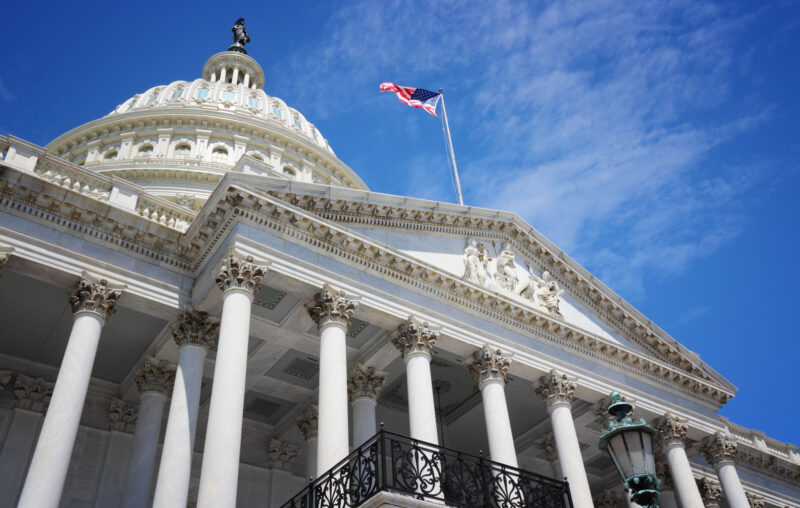
The debt ceiling standoff between President Biden and the Republican-controlled US House of Representatives indicates Republicans care about government spending and deficits again, allegedly.
But history tells a different story.
Since 1980, the national debt has risen substantially each year, regardless of whether the presidency, House, or Senate was red or blue.
In my recent interview with financial expert David Bahnsen, he said, “[Conservatives] are losing their moral credibility…we can’t only be fiscal conservatives when there’s a Democrat in the White House.”
Proving Bahnsen’s point, two-thirds of the national debt was added just since 2009: $9.3 trillion during President Obama’s eight years, $7.8 trillion over President Trump’s four years (more than half of which was added during the COVID-19 pandemic and related shutdowns), and already $3.7 trillion in President Biden’s two years, with much more to come. During the Obama and Trump terms, both Republicans or Democrats controlled Congress. Neither put the breaks on borrowing.
Spending restraint is necessary.
Spending less would help avoid default on the debt, and help reduce expected massive deficits. If deficits continue to accelerate, as the Congressional Budget Office projects with a current policy baseline, the Federal Reserve will, at some point, be forced to monetize this new debt at such a scale that the post-pandemic inflation will seem mild by comparison. Moreover, higher deficits and interest rates will result in higher net interest payments, which will soon surpass $1 trillion per year, thereby crowding out Congressional budgets and likely necessitate more spending, taxes, and inflation.
In early 2021, inflation escalated quickly after President Biden and Democrats passed the $2 trillion American Rescue Plan Act, handing out additional, unnecessary, blanket tax rebates and ratcheting up payouts to state and local governments and wasteful programs. And then there were the other costly legislative offerings of the “infrastructure” bill: the CHIPS Act, and the (inappropriately named) Inflation Reduction Act.
Then, much of this substantial new debt generated by more than $7 trillion in excessive spending since early 2020 was purchased by the Fed, more than doubling the monetary base. Burdensome regulations imposed by the Biden administration, particularly on oil and gas production, along with tax hikes, resulted in a 40-year-high inflation rate and the slowest year of economic growth during a recovery in decades. The monetary base has finally started declining – down 6.5 percent since its peak of nearly $9 trillion in April 2022–and inflation has come down slightly but remains persistently high at 6.4 percent.
Despite President Biden’s claims in his recent State of the Union address, deficits under his administration have remained near historic highs. While it’s true that the deficit has declined, it remains well above $1 trillion, and the decline was from expiring pandemic relief measures. The Congressional Budget Office finds the deficit will remain elevated well above $1 trillion and “averages $2 trillion per year from 2024 to 2033.”
That’s far from balancing the budget or, better yet, achieving a surplus that could reduce the national debt, a feat achieved in only 6 years since 1940 (1947, 1948, 1951, 1956, 1957, and 1969). And it hasn’t been sustained in a century, since Presidents William Harding then Calvin Coolidge effectively restrained government spending.
Cutting total spending is necessary. But trimming discretionary spending alone is not enough, as that will only temporarily address America’s fiscal crisis. To get out of this national crisis, we need perpetual spending restraint, like that championed by President Coolidge, which will require key reforms to “mandatory” programs like Social Security and Medicare.
While a balanced budget amendment sounds good (and would be much better than our lack of a fiscal rule at the federal level today) it would likely result in rising taxes, which would be detrimental to growth and deficit-reduction efforts. A federal spending limit tackles the ultimate burden of government: spending.
This principle works at the state level in places like Texas, where the Legislature has held the budget in check over the last decade, contributing to a $32.7 billion surplus that could provide historic tax relief. Other state think tanks are weighing this responsible-budgeting approach, limiting spending to a maximum rate of population growth plus inflation. This rate is too high now, but typically provides a stable metric that reasonably accounts for the average taxpayer’s ability to pay for government spending while growing less than the economy.
Instituting a federal spending limit would encourage Congress to narrow its scope to constitutional duties. This could be done with the Responsible American Budget, which has been supported by economists, politicians, and thought leaders, by limiting federal budget growth to correspond with population growth plus inflation.
This approach would help remove failed programs from our lives, while allowing for more free-market capitalism to support human flourishing. Had this limit been followed over the past 20 years, the US could have added just $500 billion to the national debt on a static basis, instead of the $19 trillion we got. The more likely result would have been paying down the debt, given the dynamic effects of such a pro-growth policy.
While House Republicans are trying to restrain spending for the moment, both sides of the political aisle need to encourage a bigger shift that embraces spending limits and pro-growth policies. We must cut government spending. The negotiations around raising the debt ceiling should be that opportunity to provide fiscal sanity. If not, we will have more costly consequences that Americans can’t afford.
* This article was originally published here
PUBLISH WITH US!
The Washington Gazette works at our discretion with businesses, non-profits, and other organizations. We do not work with socialists, crony capitalists, or disinformation groups. Click the green button below to view our services!
HELP STOP THE SPREAD OF FAKE NEWS!
SHARE our articles and like our Facebook page and follow us on Twitter!





0 Comments